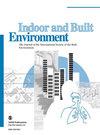在学校教室使用移动式空气净化器清除气溶胶:使用什么、在哪里使用、如何使用
IF 2.9
3区 工程技术
Q2 CONSTRUCTION & BUILDING TECHNOLOGY
引用次数: 0
摘要
移动式空气净化器(MACs)已被提议作为一种辅助解决方案,以防止呼吸道气溶胶在学校教室中传播。为了确定在哪些地方、如何使用移动式空气净化器,我们选择了七种中小型移动式空气净化器,并通过以下方法对其不同的设置和配置进行了评估:1)确定洁净空气输送率(CADR)的衰减测试;2)由一组受试者进行的感知测试,以及噪音和空气流动的物理测量。研究结果表明,要达到理想的洁净空气输送率(每间教室 30 名学生,约 1000 立方米/小时),关键因素是诱导气流模式和汽车空调的位置。与水平送风(最大 219-333 m3/h)相比,向占用区域向上送风的移动空调显示出更高的 CADR(最大 775-1332 m3/h)。此外,当房间面积增大时,同时使用多个设备是至关重要的,结合机械通风可以提高气溶胶去除率。达到足够的 CADR 总是会导致噪音水平超过 35 dB(A)的限制,但有时面板的额定值超过 50%。气流速度大多符合要求(0.2 m/s),这与小组的正面评价一致。因此,由受试者组成的小组进行评估有助于优化教室中汽车空调的使用。本文章由计算机程序翻译,如有差异,请以英文原文为准。
Using mobile air cleaners in school classrooms for aerosol removal: Which, where and how
Mobile air cleaners (MACs) have been proposed as a supplementary solution to combat the spread of respiratory aerosols in school classrooms. To determine which, where and how to use MACs, seven small- and medium-sized MACs were selected and assessed for different settings and configurations by 1) a decay test for determining the clean air delivery rate (CADR), and 2) a perception test with a panel of subjects, together with physical measurements, of noise and air movement. The findings show that to achieve the desired CADR (appr. 1000 m3 /h for 30 students per classroom), the key factors are the induced airflow pattern and the location of the MACs. MACs with an upward air supply toward the occupied zone showed much higher CADR (max. 775–1332 m3 /h) than those with a horizontal air supply (max. 219–333 m3 /h). Moreover, using multiple devices simultaneously was crucial when the room size was increased, and combining mechanical ventilation could improve aerosol removal. Achieving a sufficient CADR would always lead to a noise level above the limit of 35 dB(A), yet sometimes the rating of the panel was more than 50% acceptable. The air velocities mostly fulfilled the requirement (<0.2 m/s), which aligned with the positive panel assessment. Hence, the evaluation by a panel of subjects can help to optimize the use of MACs in a classroom.
求助全文
通过发布文献求助,成功后即可免费获取论文全文。
去求助
来源期刊

Indoor and Built Environment
环境科学-工程:环境
CiteScore
6.40
自引率
25.00%
发文量
130
审稿时长
2.6 months
期刊介绍:
Indoor and Built Environment publishes reports on any topic pertaining to the quality of the indoor and built environment, and how these might effect the health, performance, efficiency and comfort of persons living or working there. Topics range from urban infrastructure, design of buildings, and materials used to laboratory studies including building airflow simulations and health effects. This journal is a member of the Committee on Publication Ethics (COPE).
 求助内容:
求助内容: 应助结果提醒方式:
应助结果提醒方式:


